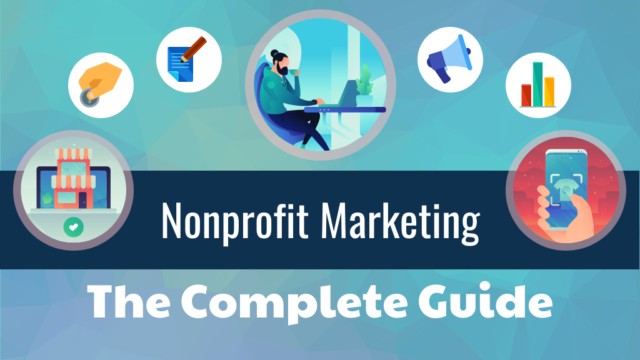In today’s digital age, effective marketing is essential for nonprofits seeking to raise awareness, attract donors, and engage with their communities. Digital marketing offers nonprofits a cost-effective way to reach a broader audience and create meaningful connections. In this blog, we’ll explore how nonprofits can leverage digital marketing strategies to achieve their goals and make a lasting impact.

1. Build a User-Friendly Website
A well-designed, user-friendly website is the cornerstone of any nonprofit’s digital marketing efforts. It serves as the primary platform for sharing your mission, programs, and ways to get involved.
Key Elements of a Nonprofit Website:
- Clear Mission Statement: Clearly articulate your mission and the impact of your work on the homepage.
- Donation Options: Make it easy for visitors to donate by providing a straightforward donation process with multiple payment options.
- Engaging Content: Include compelling stories, videos, and images that showcase your work and connect with potential supporters emotionally.
- Mobile Optimization: Ensure your website is mobile-friendly, as many users will access it via smartphones and tablets.
2. Utilize Social Media
Social media platforms are powerful tools for nonprofits to engage with their audience, share updates, and promote events. Each platform offers unique opportunities for storytelling and interaction.
Tips for Effective Social Media Use:
- Choose the Right Platforms: Focus on platforms where your target audience is most active, such as Facebook, Instagram, Twitter, or LinkedIn.
- Share Compelling Stories: Highlight the individuals or communities impacted by your work through stories and testimonials.
- Engage Your Audience: Encourage followers to share their experiences and engage with your content by asking questions and responding to comments.
- Use Visual Content: Incorporate images, videos, and infographics to capture attention and convey your message effectively.
3. Create an Email Marketing Strategy
Email marketing is a valuable tool for maintaining communication with supporters, sharing updates, and promoting fundraising campaigns. It allows you to build relationships and keep your audience informed.
Best Practices for Email Marketing:
- Build a Subscriber List: Encourage website visitors and social media followers to sign up for your email list by offering valuable content, such as newsletters or exclusive updates.
- Segment Your Audience: Tailor your messaging by segmenting your email list based on donor history, interests, or engagement level.
- Craft Compelling Content: Use engaging subject lines and personalize your emails to capture attention. Include calls to action (CTAs) that encourage recipients to donate, volunteer, or share your message.
- Measure and Optimize: Track open rates, click-through rates, and conversions to understand what works best and continuously improve your email campaigns.
4. Leverage Content Marketing
Content marketing involves creating valuable, relevant content to attract and engage your target audience. It can help establish your nonprofit as a thought leader and drive traffic to your website.
Strategies for Effective Content Marketing:
- Blogging: Start a blog that shares insights, success stories, and industry trends related to your mission. This can help educate your audience and improve your search engine rankings.
- Video Content: Create videos that showcase your work, tell powerful stories, or explain your mission. Videos can be shared on social media, your website, or video platforms like YouTube.
- Infographics and Visuals: Use infographics to present data and statistics related to your cause in a visually appealing way, making it easier for your audience to understand the impact of your work.
5. Implement Search Engine Optimization (SEO)
SEO is crucial for improving your website’s visibility on search engines. By optimizing your content for search engines, you can attract more visitors to your website and raise awareness about your nonprofit.
SEO Best Practices:
- Keyword Research: Identify relevant keywords that your target audience may use to search for information related to your mission. Incorporate these keywords into your website content, blog posts, and metadata.
- Optimize On-Page Elements: Ensure that your website’s titles, headings, and images are optimized for search engines. Use descriptive alt tags for images and create engaging meta descriptions for your pages.
- Build Backlinks: Collaborate with other organizations, bloggers, or media outlets to secure backlinks to your website. This can improve your search engine ranking and drive traffic.
6. Use Paid Advertising
While organic reach is essential, paid advertising can help nonprofits reach a wider audience quickly. Platforms like Facebook and Google Ads offer targeted advertising options that can be effective for fundraising campaigns.
Tips for Successful Paid Advertising:
- Define Your Goals: Determine what you want to achieve with your advertising campaigns, whether it’s raising funds, increasing event attendance, or building brand awareness.
- Target Your Audience: Use demographic, geographic, and interest-based targeting to reach individuals most likely to support your cause.
- Create Compelling Ads: Design eye-catching ads with clear messaging and strong CTAs that encourage users to take action.
7. Measure and Analyze Performance
To ensure the effectiveness of your digital marketing efforts, it’s crucial to measure and analyze performance regularly. This data can provide insights into what strategies are working and where improvements are needed.
Key Metrics to Track:
- Website Traffic: Monitor the number of visitors to your website and which pages they visit most frequently.
- Engagement Rates: Analyze engagement metrics on social media platforms, such as likes, shares, comments, and followers gained.
- Email Performance: Track open rates, click-through rates, and conversion rates for your email campaigns.
- Donation Tracking: Measure the effectiveness of your fundraising efforts by tracking the number of donations received and the average donation amount.
Conclusion
Digital marketing presents a wealth of opportunities for nonprofits to connect with supporters, raise awareness, and drive donations. By building a user-friendly website, leveraging social media, implementing effective email marketing strategies, and utilizing content marketing, nonprofits can significantly enhance their outreach efforts. Embracing data analysis and continuous improvement will ensure that your digital marketing strategies remain effective and impactful. With the right approach, your nonprofit can thrive in the digital landscape and make a difference in the communities you serve.


No responses yet